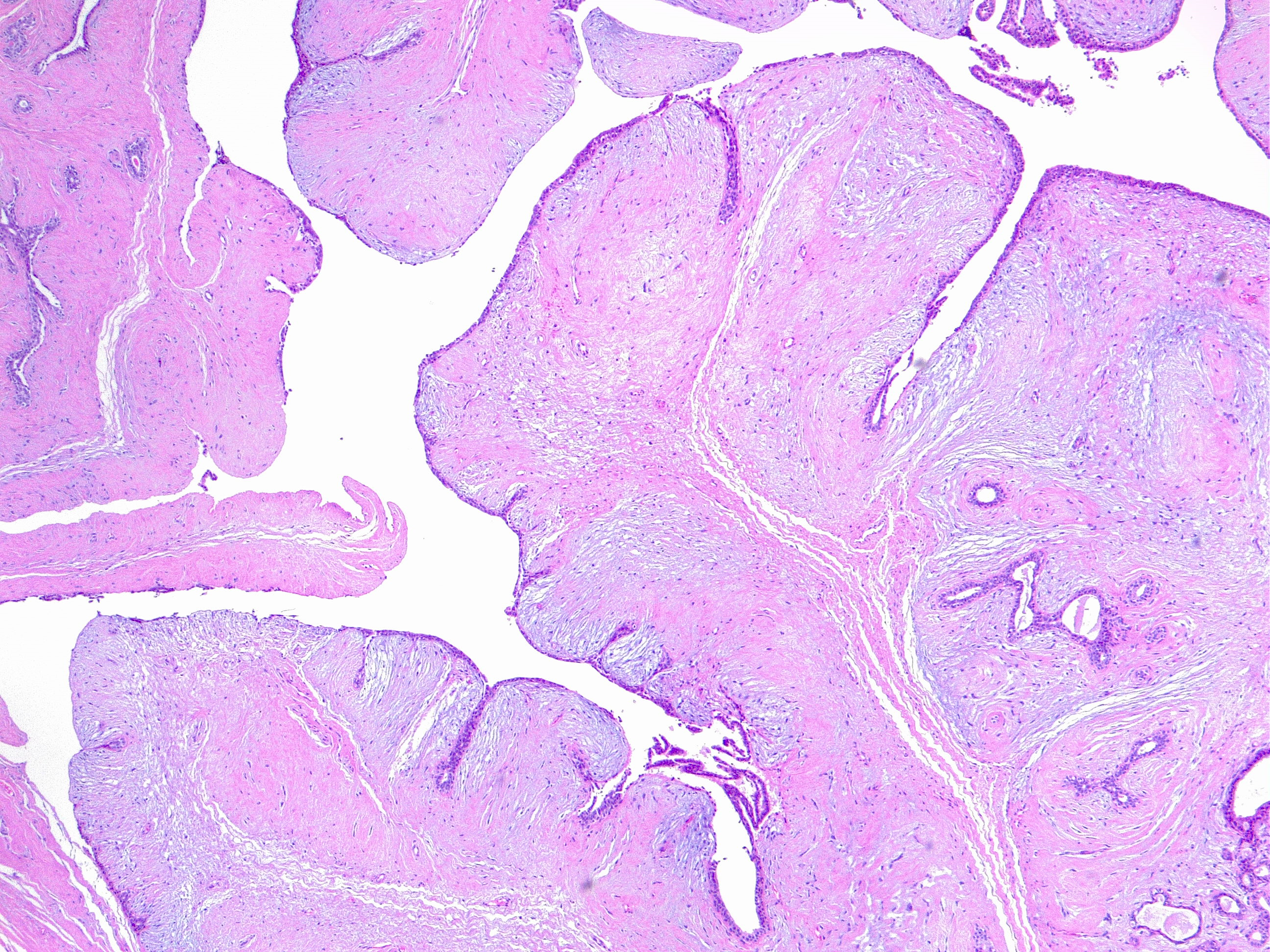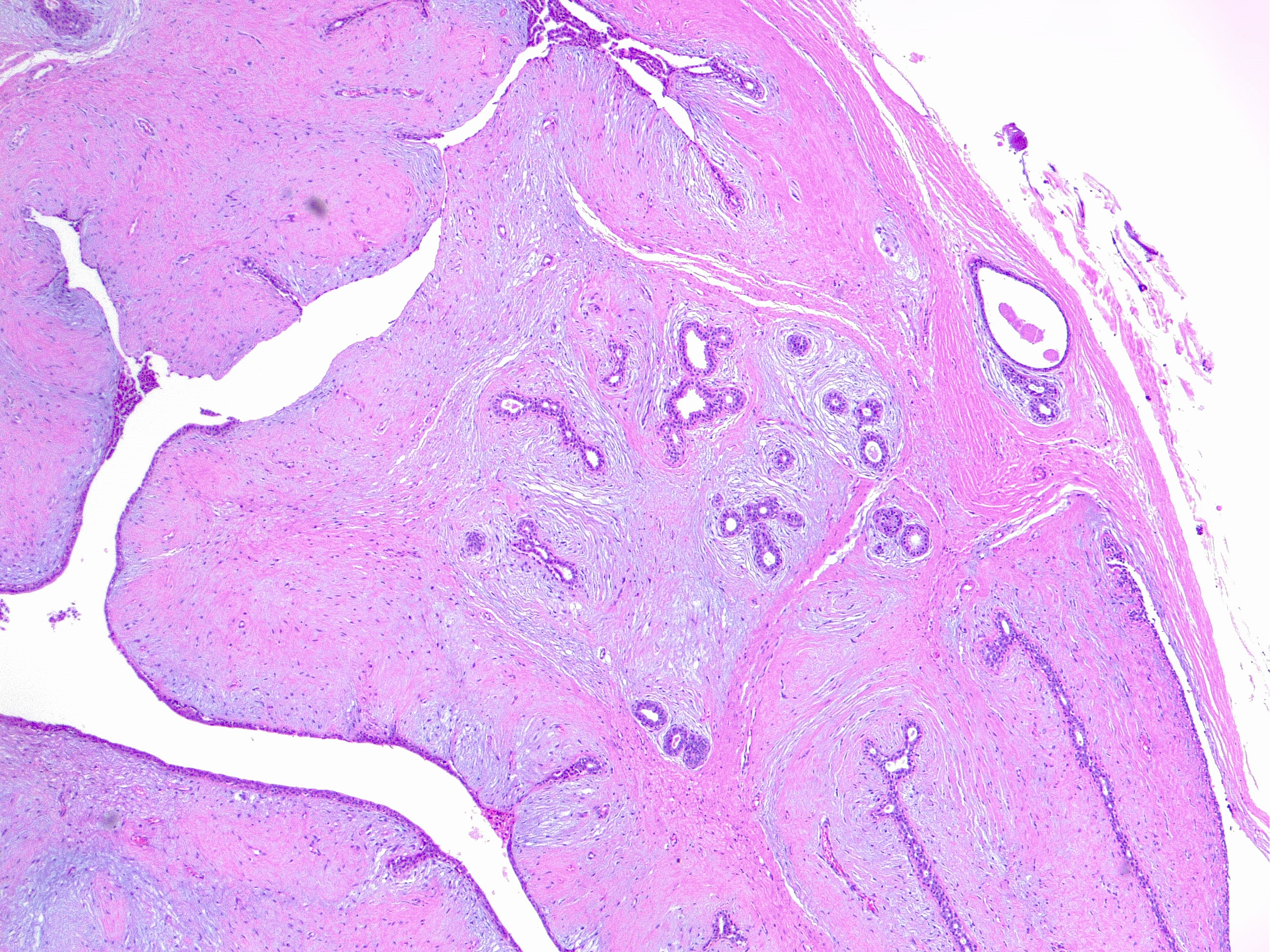[1]
Zhang Y,Kleer CG, Phyllodes Tumor of the Breast: Histopathologic Features, Differential Diagnosis, and Molecular/Genetic Updates. Archives of pathology
[PubMed PMID: 27362571]
[2]
Foucar CE,Hardy A,Siziopikou KP,Wang L,Parini V,Hansen N,Jeruss JS, A mother and daughter with phyllodes tumors of the breast. Clinical breast cancer. 2012 Oct;
[PubMed PMID: 22981939]
[4]
Mishra SP,Tiwary SK,Mishra M,Khanna AK, Phyllodes tumor of breast: a review article. ISRN surgery. 2013;
[PubMed PMID: 23577269]
[5]
Jing P,Wei B,Yang X, Phyllodes tumor of the breast with nipple discharge: A case report. Medicine. 2018 Dec;
[PubMed PMID: 30593154]
Level 3 (low-level) evidence
[6]
Ansah-Boateng Y,Tavassoli FA, Fibroadenoma and cystosarcoma phyllodes of the male breast. Modern pathology : an official journal of the United States and Canadian Academy of Pathology, Inc. 1992 Mar;
[PubMed PMID: 1315437]
[7]
Adesoye T,Neuman HB,Wilke LG,Schumacher JR,Steiman J,Greenberg CC, Current Trends in the Management of Phyllodes Tumors of the Breast. Annals of surgical oncology. 2016 Oct;
[PubMed PMID: 27334214]
[8]
Mitus JW,Blecharz P,Jakubowicz J,Reinfuss M,Walasek T,Wysocki W, Phyllodes tumors of the breast. The treatment results for 340 patients from a single cancer centre. Breast (Edinburgh, Scotland). 2019 Feb;
[PubMed PMID: 30521986]
[9]
Faridi SH,Siddiqui B,Ahmad SS,Aslam M, Progression of Fibroadenoma to Malignant Phyllodes Tumour in a 14-Year Female. Journal of the College of Physicians and Surgeons--Pakistan : JCPSP. 2018 Jan;
[PubMed PMID: 29290198]
[10]
Laé M,Vincent-Salomon A,Savignoni A,Huon I,Fréneaux P,Sigal-Zafrani B,Aurias A,Sastre-Garau X,Couturier J, Phyllodes tumors of the breast segregate in two groups according to genetic criteria. Modern pathology : an official journal of the United States and Canadian Academy of Pathology, Inc. 2007 Apr;
[PubMed PMID: 17334353]
[11]
Jones AM,Mitter R,Springall R,Graham T,Winter E,Gillett C,Hanby AM,Tomlinson IP,Sawyer EJ, A comprehensive genetic profile of phyllodes tumours of the breast detects important mutations, intra-tumoral genetic heterogeneity and new genetic changes on recurrence. The Journal of pathology. 2008 Apr;
[PubMed PMID: 18288784]
[12]
Noronha Y,Raza A,Hutchins B,Chase D,Garberoglio C,Chu P,Weiss L,Wang J, CD34, CD117, and Ki-67 expression in phyllodes tumor of the breast: an immunohistochemical study of 33 cases. International journal of surgical pathology. 2011 Apr;
[PubMed PMID: 21087983]
Level 3 (low-level) evidence
[13]
Tan PH,Jayabaskar T,Yip G,Tan Y,Hilmy M,Selvarajan S,Bay BH, p53 and c-kit (CD117) protein expression as prognostic indicators in breast phyllodes tumors: a tissue microarray study. Modern pathology : an official journal of the United States and Canadian Academy of Pathology, Inc. 2005 Dec;
[PubMed PMID: 16258510]
[14]
Tse GM,Lui PC,Vong JS,Lau KM,Putti TC,Karim R,Scolyer RA,Lee CS,Yu AM,Ng DC,Tse AK,Tan PH, Increased epidermal growth factor receptor (EGFR) expression in malignant mammary phyllodes tumors. Breast cancer research and treatment. 2009 Apr;
[PubMed PMID: 18443904]
[15]
Karim RZ,Gerega SK,Yang YH,Spillane A,Carmalt H,Scolyer RA,Lee CS, p16 and pRb immunohistochemical expression increases with increasing tumour grade in mammary phyllodes tumours. Histopathology. 2010 Jun;
[PubMed PMID: 20497245]
[16]
Yonemori K,Hasegawa T,Shimizu C,Shibata T,Matsumoto K,Kouno T,Ando M,Katsumata N,Fujiwara Y, Correlation of p53 and MIB-1 expression with both the systemic recurrence and survival in cases of phyllodes tumors of the breast. Pathology, research and practice. 2006;
[PubMed PMID: 16889904]
Level 3 (low-level) evidence
[17]
Niezabitowski A,Lackowska B,Rys J,Kruczak A,Kowalska T,Mitus J,Reinfuss M,Markiewicz D, Prognostic evaluation of proliferative activity and DNA content in the phyllodes tumor of the breast: immunohistochemical and flow cytometric study of 118 cases. Breast cancer research and treatment. 2001 Jan;
[PubMed PMID: 11245343]
Level 3 (low-level) evidence
[18]
Tan WJ,Thike AA,Bay BH,Tan PH, Immunohistochemical expression of homeoproteins Six1 and Pax3 in breast phyllodes tumours correlates with histological grade and clinical outcome. Histopathology. 2014 May;
[PubMed PMID: 24438019]
Level 2 (mid-level) evidence
[19]
Gullett NP,Rizzo M,Johnstone PA, National surgical patterns of care for primary surgery and axillary staging of phyllodes tumors. The breast journal. 2009 Jan-Feb;
[PubMed PMID: 19141133]
[20]
Tan H,Zhang S,Liu H,Peng W,Li R,Gu Y,Wang X,Mao J,Shen X, Imaging findings in phyllodes tumors of the breast. European journal of radiology. 2012 Jan;
[PubMed PMID: 21353414]
[21]
Liberman L,Bonaccio E,Hamele-Bena D,Abramson AF,Cohen MA,Dershaw DD, Benign and malignant phyllodes tumors: mammographic and sonographic findings. Radiology. 1996 Jan;
[PubMed PMID: 8539362]
[22]
Yoo JL,Woo OH,Kim YK,Cho KR,Yong HS,Seo BK,Kim A,Kang EY, Can MR Imaging contribute in characterizing well-circumscribed breast carcinomas? Radiographics : a review publication of the Radiological Society of North America, Inc. 2010 Oct;
[PubMed PMID: 21071383]
[23]
Pezner RD,Schultheiss TE,Paz IB, Malignant phyllodes tumor of the breast: local control rates with surgery alone. International journal of radiation oncology, biology, physics. 2008 Jul 1;
[PubMed PMID: 18234448]
[24]
Ruiz-Flores L,Ebuoma LO,Benveniste MF,Nagi C,OrtizPerez T,Benveniste AP, Case Report: Metastatic Phyllodes Tumor. Seminars in ultrasound, CT, and MR. 2018 Feb;
[PubMed PMID: 29317034]
Level 3 (low-level) evidence
[25]
Yasir S,Nassar A,Jimenez RE,Jenkins SM,Hartmann LC,Degnim AC,Frost M,Visscher DW, Cellular fibroepithelial lesions of the breast: A long term follow up study. Annals of diagnostic pathology. 2018 Aug;
[PubMed PMID: 30029048]
[26]
Goto W,Kashiwagi S,Takada K,Asano Y,Morisaki T,Noda S,Takashima T,Onoda N,Hirakawa K,Ohira M, [A Case of a Malignant Phyllodes Tumor That Was Difficult to Distinguish from Stromal Sarcoma]. Gan to kagaku ryoho. Cancer
[PubMed PMID: 30692487]
Level 3 (low-level) evidence
[27]
Burga AM,Tavassoli FA, Periductal stromal tumor: a rare lesion with low-grade sarcomatous behavior. The American journal of surgical pathology. 2003 Mar;
[PubMed PMID: 12604890]
[28]
Tan PH,Thike AA,Tan WJ,Thu MM,Busmanis I,Li H,Chay WY,Tan MH, Predicting clinical behaviour of breast phyllodes tumours: a nomogram based on histological criteria and surgical margins. Journal of clinical pathology. 2012 Jan;
[PubMed PMID: 22049216]


